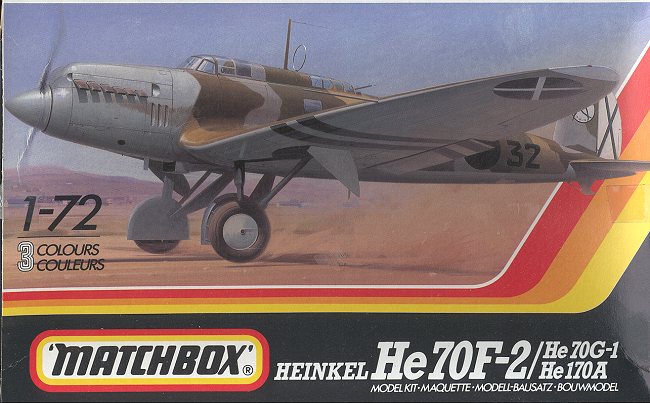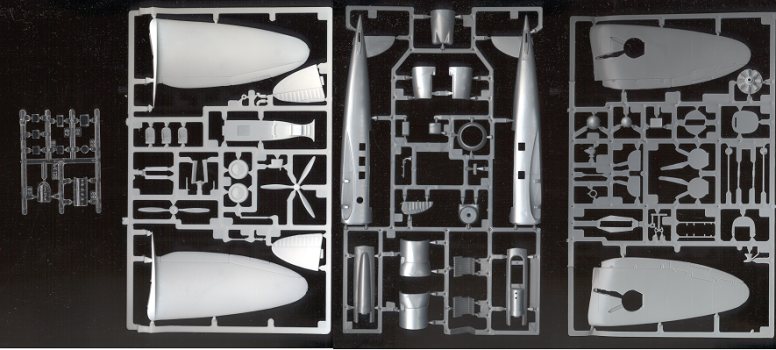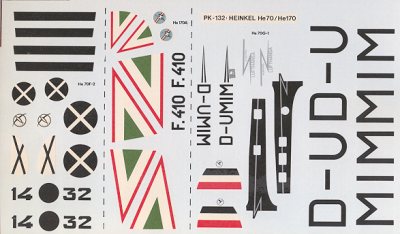
| KIT: | Matchbox 1/72 He-70 'Blitz' |
| KIT # | PK-132 |
| PRICE: | $10.00 |
| DECALS: | One aircraft |
| REVIEW & | |
| NOTES: |

| HISTORY |
The Heinkel He-70 was a German response to the fast LockheedOrion single engined passenger aircraft of 1931. Actually, it was the He-65 thatwas the original design, but it was soon obvious that the fixed gear He-65 wouldnot be fast enough and work on that was stopped. The He-70 used ever aerodynamicrefinement available to make it the faster than the Orion.
Heinkel used retractable main landing gear and a closely cowled630 hp BMW V1 liquid cooled V-12. This engine used glycol instead of water forcoolant to keep the radiator as small as possible. Work was not only done on theprototype, but production aircraft as well, first flight of the He-70v1 beingmade in late 1932. It was named Blitz (lightning) because it was fasterthan even contemporary fighters at 234 mph. Production versions entered servicewith DLH in mid 1934. One was used by Rolls Royce as an engine testbed, flyinguntil1944!
Because of its speed, it was perfect for the new Luftwaffe andseveral were bought as the He-70F as a reconnaissance and high speed courieraircraft. The He-70 was also sent to do duty in the Spanish Civil War, 18examples seeing duty there and staying with the Spanish Air Force until the lastone was retired in the early 1950s. However, the He-70 was not the aircraft thatthe Luftwaffe actually wanted and by the start of the war, it was replaced byother aircraft. By this time it was also no longer in service with DLH.
The He-70 was modified with a 910 hp Gnome Rhone radial and assuch was flown by the Hungarian Air Force. However, it proved to be vulnerableto defending fire and was soon withdrawn from front line service. The typecarried on until the end in various second-line units, despite its age and thedislike of most crews that flew it. None of the 234 examples built havesurvived.
| THE KIT |

Before Matchbox stopped making new kits, they had gotten pretty sophisticated.Though some kits still had the trenches that passed for panel lines, a number ofthe later kits were very nice. If nothing else, Matchbox provided some prettyincredible kits that most mainstream manufacturers wouldn't touch. The He-70 isone of those. What is more, one can make the radial engined He-170 from thissame kit without having to buy another model to do so.
This kitis in three different colors of plastic. For some reason, Matchbox thought thatwould be a sales point. Detailing is raised panel lines and some of the detailis a touch soft. There is an interior that includes some detail in the passengercompartment, but there is lots of room for improvement. The cockpit consists oftwo seats and a control stick, where the aft compartment has either a singleseat for the military version or a pair of bench seats for the airliner.
Doingthe different versions is quite easy and all the required bits and pieces arethere to let you do any of the three variants offered. As with all Matchboxkits, the fit of the parts is probably very good, despite the rather large seamsthat will invariably be there. There is no wheel well detail and they are notboxed in. Transparencies are thick with large frames. Those in the fuselage areflush fitting so will be tricky to glue in place.
 Instructions are a 20 step process with all colorslisted in a separate section of the sheet. Color callouts are generic as istypical of the time. Interestingly, in the German language section of the colorguide, some RLM colors are given, but no where else! Decals are very good andfor three aircraft. First is a civil He-70G of Lufthansa circa 1935. This is insilver and black. Next is a Spanish Civil War He-70F-1 from 2 Gruppo of theSpanish Nationalist Air Force in 1937. Finally a radial engined He-170A from theHungarian Air Force of 1939. Both military aircraft will be interesting to paintas they have a rather complicated upper color scheme.
Instructions are a 20 step process with all colorslisted in a separate section of the sheet. Color callouts are generic as istypical of the time. Interestingly, in the German language section of the colorguide, some RLM colors are given, but no where else! Decals are very good andfor three aircraft. First is a civil He-70G of Lufthansa circa 1935. This is insilver and black. Next is a Spanish Civil War He-70F-1 from 2 Gruppo of theSpanish Nationalist Air Force in 1937. Finally a radial engined He-170A from theHungarian Air Force of 1939. Both military aircraft will be interesting to paintas they have a rather complicated upper color scheme.
Overall itshouldn't be that difficult to build and will definitely look very nice in your1/72 aircraft collection.
| REFERENCES |
German Aircraft of the Second World War by JH Smith andAntony Kay, Putanm, 1972
Review kit courtesy of me and my wallet!
If you would like your product reviewed fairly and fairly quickly by asite that has over 1,100 visits a day, please contactme or see other details in the